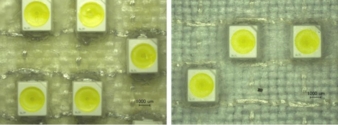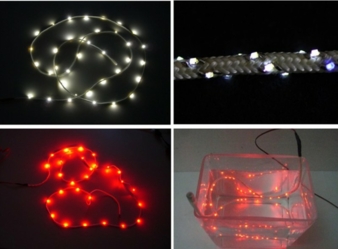20/07/2015 — auf Deutsch lesen
TITV Greiz: Sensory applications in micro-systems technology
Sensors are a basic requirement and the main initiator when textiles have to be equipped with intelligent functions. At the present this development is dominated by the adaption of conventional sensing elements (e.g. electronic circuits) thus textile typical characteristics of goods are affected and production costs rise up due to additional fabrication steps. Textile pre-products which are assembled with micro-parts represent a cost-efficient way to integrate microelectronic sensors into textiles.
Textile pre-products which are assembled with micro-parts represent a cost-efficient way to integrate microelectronic sensors into textiles using a manageable variety of components and under far-reaching application of conventional textile machinery.
When micro-parts have to be mounted on a textile carrier high precision requirements must be taken into account during the whole textile manufacturing process. Furthermore, the textile material is subject to a considerable thermal load since electrical contacts are formed using a reflow soldering technique. So finishing plays an especially important role since both the distances between conducting traces in the textile and its thermal stability are determined within this manufacturing step. Passivation of the textile circuit arrangement against environmental influences is done using coatings made of various polymers such as silicone, polyurethane, and acrylate resin.
An accomplished research project aimed at the development of industrially practicable manufacturing methods for textile substrates which had to be equipped with microelectronic parts. Jacquard weaving as well as braiding were chosen as appropriate production methods for an arrangement of conducting threats within the textile. In this way, a kind of “textile circuit board” was formed. The precision requirements for the production process were derived from relevant standards of the electronic industry above all IPC-2221 “Generic Standard on Printed Board Design” where level A, which represents the lowest precision requirements, prescribes a production tolerance less than ± 0.06 mm.
Electrical connections were prepared using a lead-free Sn-Bi alloy. After soldering paste printing the electronic components were placed onto the textile carrier and soldering was performed at 180 °C in a reflow oven. Finally the electronic components were encapsulated by a partial or entire coating with plastics. Hereby various techniques such as dip or spray coating, laminating and screen printing were applied (Fig. 1).
The textile substrates were made of polyester yarns whereas polyetheretherketone (PEEK) and glass fibres were used for high temperature applications. A practicable technology concept with reasonable process reliability was demonstrated on the basis of a textile tape equipped with light emitting diodes and waterproof finishing. These woven or braided luminous textiles are profitably producible as a running tape (Fig. 2 or 3).
The results were implemented in the demonstration model of a fibre-optic textile-integrated sensor assembly which incorporates microelectronic, fibre-optic and textile components as an entity. The sensor assembly utilizes the method of the gallium arsenide based fibre-optic temperature measurement which ensures a fast and accurate temperature measurement. This method possesses an ever more growing importance since it is insensitive to electromagnetic troubles. Prospective applications reach from sensor equipped protective clothing against electromagnetic fields up to medical textiles used in Magnetic Resonance Imaging (MRI) devices. The sensor fibres were interwoven into the textile (Fig. 4). Electrical contacts were prepared by soldering or micro rivet connections.
It has been shown that production costs of sensorized textiles can be considerably reduced by continuously running textile manufacturing processes with the output of machine-ready parts. Along with the project, functional tests for smart textiles and means for reliability enhancements were derived. The TITV Greiz offers its services as a research partner for textile companies in implementing the results by application-specific adaptations.
The IGF project 17588 BR of the Research Association Forschungskuratorium Textil was funded via the AiF as part of the program to support Industrial Community Research (IGF) by the Federal Ministry for Economic Affairs and Energy, based on a resolution of the German Bundestag. The final report is available for the general public in the Federal Republic of Germany.





